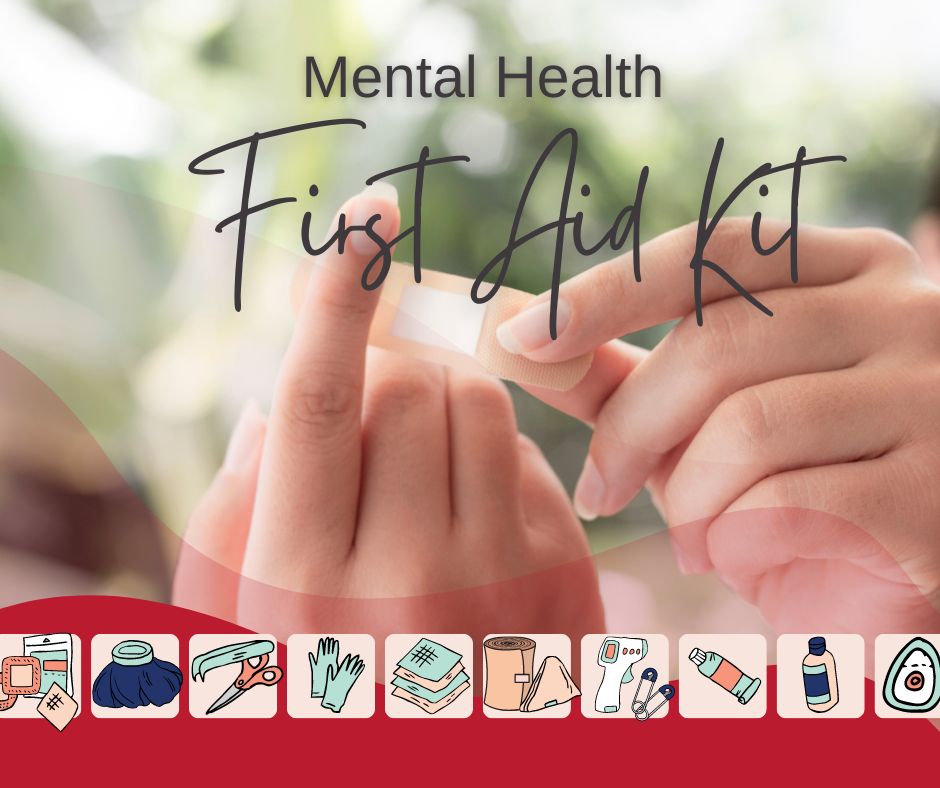The Grove

Mental Health First-Aid Kit: Curate Your Social Media
Social media and the online experience can be great for connecting, educating, and entertainment but social media isn’t all good. There are plenty of ways our social feeds fuel poor mental health. The eye patch protects our eyes from further injury by keeping out debris and helping us not rub the wound. Similarly, curating our social feed can protect our mental health. Be intentional about who you follow and remember that you can always silence, block, report, unfollow people and companies that wear you down.

Mental Health First-Aid: Recognize Overstimulation
Overstimulation can happen when too many pressures and demands begin to feel overwhelming. Everyone experiences overstimulation differently and as part of the Mental Health First-Aid Kit, it’s important to know what your triggers are and what overstimulation looks like for you. When you start seeing signs of overstimulation, take it as a reminder to add more coping mechanisms, practice mindfulness, or take a step away so that you can reground and feel more at ease.

Building Your Mental Health First-Aid Kit
What would you put in your Mental Health First-Aid Kit? We all know that first-aid kits are helpful when there is a physical emergency but what about for our mental health? Are there “items” we could get ready for when our mental health is being tested? We have put together a list of tips and best practices to make sure that you’re ready when theres an emotional setback or crisis.

Attention Restoration Theory: Understanding the Relationship between Nature and Mental Health
Attention restoration theory is a concept that suggests that spending time in nature can help us restore our mental resources and improve our well-being. The theory is based on the idea that our brains have two types of attention: voluntary and involuntary. Voluntary attention is what we use when we focus on a task that requires concentration, while involuntary attention is what we use when we react to stimuli in our environment.
According to attention restoration theory, spending time in nature allows our involuntary attention to rest, which in turn helps to restore our voluntary attention. This restoration effect can lead to increased productivity, creativity, and attention capacity.
In this blog post, we will explore the concept of attention restoration theory in more detail, including how it works, the benefits of spending time in nature, and how we can use this theory to improve our mental health. Whether you're a nature lover or someone who's simply interested in exploring new ways to boost your well-being, this post is for you. So let's dive in and learn more about attention restoration theory!

Green Therapy: How Caring for Plants Can Improve Your Mental Health
Looking for an enjoyable and natural way to boost your mood and improve your mental health? Caring for plants can be a surprisingly effective method! Not only do plants add a touch of natural beauty to your living space, but studies have shown that spending time around plants can have a positive impact on mood and overall well-being. This article explores the mental health benefits of plant care, including how it can be a natural stress-reliever, promote mindfulness, provide a sense of accomplishment, and allow you to learn and adapt. Whether you're a seasoned green thumb or a beginner looking to try something new, this article will show you how caring for plants can help improve your mental health and add a little natural beauty to your life.

Bedtime Snacks: A Guide to Healthy and Sleep-Friendly Options
Unsure if eating right before bed is a good idea? Going to sleep with a full stomach may seem like a bad idea but snacking before bed might actually help you get better rest. What snacks are best before bed if you want still want to get good sleep? These snacks are best for adults and children and won't cost you a wink of shut-eye.

Achieving Inner Harmony: The Importance of Attunement in Lifespan Integration
What do you know about Lifespan Integration? If you have a general idea of what this new therapy is all about, you may be wondering about some of its principles. Attunement is an important part of Lifespan Integration and necessary in achieving inner harmony.





Inner Child Work
The practice of inner child work involves connecting with a younger version of yourself to provide compassion and gain understanding. This can be achieved by visualizing a picture of yourself as a child and using prompts to start the conversation. Inner child work is not necessary for everyone, but it can be a helpful tool in gaining insight and practicing self-compassion. To start exploring your inner child, consider areas such as shame, emotional soothing, self-betrayal, silence, and safety. For more resources on inner child work, check out the recommended meditation or book.

How to do an Emotional Inventory
The blog post discusses the importance of doing an emotional inventory to increase self-awareness and understand one's emotional state. It explains that emotional inventory involves taking stock of one's emotions, identifying their triggers, and understanding how they manifest in behavior. The post provides several steps to conduct an emotional inventory, including creating a safe space, identifying emotions, assessing how the emotions are triggered, and analyzing how they affect behavior. By regularly practicing emotional inventory, one can increase their emotional intelligence, improve communication skills, and strengthen relationships.

What is Postpartum Depression?
Postpartum depression is a condition that affects many women after giving birth or becoming a new parent. In this blog post, we explore what postpartum depression is, its symptoms, causes, and treatment options. We also provide information on how to seek help, emphasizing the importance of early intervention in promoting recovery.
